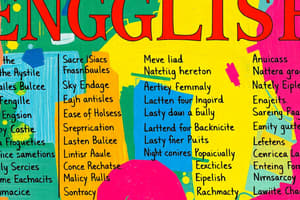Podcast
Questions and Answers
शब्दावली का महत्व क्या है?
शब्दावली का महत्व क्या है?
शब्दावली प्रभावी संप्र communication और समझ के लिए महत्वपूर्ण है।
शब्दावली बढ़ाने के लिए एक प्रभावी रणनीति क्या है?
शब्दावली बढ़ाने के लिए एक प्रभावी रणनीति क्या है?
नियमित रूप से पढ़ाई करना नई शब्दों के संपर्क में आने का एक अच्छा तरीका है।
सर्वनाम, क्रिया और विशेषण किस प्रकार के भाषाई घटक हैं?
सर्वनाम, क्रिया और विशेषण किस प्रकार के भाषाई घटक हैं?
ये सभी भाषाई घटक भागों के नाम (Parts of Speech) हैं।
किसी वाक्य में विषय-क्रिया संबंध का क्या महत्व है?
किसी वाक्य में विषय-क्रिया संबंध का क्या महत्व है?
SQ3R विधि का क्या अर्थ है?
SQ3R विधि का क्या अर्थ है?
किसी कहानी में मुख्य विचार को कैसे पहचाना जा सकता है?
किसी कहानी में मुख्य विचार को कैसे पहचाना जा सकता है?
प्रक्रियात्मक लेखन में 'संशोधन' का क्या अर्थ है?
प्रक्रियात्मक लेखन में 'संशोधन' का क्या अर्थ है?
किसी साहित्यिक कार्य में 'थीम' का क्या महत्व है?
किसी साहित्यिक कार्य में 'थीम' का क्या महत्व है?
पात्र विकास (Characterization) का क्या अर्थ होता है?
पात्र विकास (Characterization) का क्या अर्थ होता है?
What is the main idea in a text?
What is the main idea in a text?
How can context clues assist in understanding unfamiliar words?
How can context clues assist in understanding unfamiliar words?
What are the common parts of speech in English?
What are the common parts of speech in English?
Why is drafting important in the writing process?
Why is drafting important in the writing process?
What role do supporting details play in a text?
What role do supporting details play in a text?
What is contextual learning in vocabulary development?
What is contextual learning in vocabulary development?
Why is punctuation important in writing?
Why is punctuation important in writing?
What is the purpose of seeking feedback in writing?
What is the purpose of seeking feedback in writing?
What is the difference between narrative and persuasive writing?
What is the difference between narrative and persuasive writing?
How can summarizing paragraphs aid in reading comprehension?
How can summarizing paragraphs aid in reading comprehension?
Flashcards are hidden until you start studying
Study Notes
Vocabulary Development
- Importance of Vocabulary: Critical for effective communication and comprehension.
- Strategies for Growth:
- Reading Regularly: Exposure to new words in context.
- Use of Flashcards: To memorize definitions and usage.
- Word Maps: Visual representation of word meanings and associations.
- Contextual Learning: Learning new words through sentences and examples.
- Resources: Thesauruses, dictionaries, vocabulary apps.
Grammar
- Basic Components:
- Parts of Speech: Nouns, verbs, adjectives, adverbs, pronouns, conjunctions, prepositions, interjections.
- Sentence Structure: Subject, verb, object; simple, compound, complex sentences.
- Key Rules:
- Subject-Verb Agreement: Singular subjects require singular verbs.
- Tense Usage: Consistency in past, present, and future.
- Punctuation: Commas, periods, apostrophes, quotation marks, etc.
- Common Mistakes:
- Misplaced modifiers, run-on sentences, comma splices.
Reading Comprehension
- Skills Development:
- Active Reading: Engaging with the text through annotating and summarizing.
- Inference Making: Understanding implied meanings beyond the text.
- Main Idea Identification: Distinguishing between main ideas and supporting details.
- Techniques:
- SQ3R Method: Survey, Question, Read, Recite, Review.
- Graphic Organizers: Charts and maps to outline information.
- Assessment:
- Quizzes, summaries, discussions to gauge understanding.
Writing Skills
- Types of Writing:
- Narrative: Telling a story with a clear beginning, middle, and end.
- Expository: Explaining a topic with facts and information.
- Persuasive: Arguing a position or viewpoint.
- Process:
- Prewriting: Brainstorming and outlining ideas.
- Drafting: Writing initial versions without worrying about perfection.
- Revising: Improving structure, clarity, and style.
- Editing: Correcting grammar, punctuation, and spelling errors.
- Style and Voice: Importance of finding a unique writing style and maintaining a consistent voice.
Literature Analysis
- Elements of Literature:
- Theme: Central ideas or messages in a text.
- Characterization: Development of characters and their roles.
- Plot Structure: Exposition, rising action, climax, falling action, resolution.
- Setting: Time and place where the story occurs.
- Critical Approaches:
- Formalism: Focuses on the text itself.
- Reader-Response: Emphasizes reader's interpretation.
- Historical: Context of the time period and author's background.
- Techniques:
- Close Reading: Detailed examination of passages.
- Literary Devices: Analyzing symbolism, imagery, and figurative language.
शब्दावली विकास
- शब्दावली का महत्व: प्रभावी संचार और समझ के लिए आवश्यक।
- वृद्धि के लिए रणनीतियाँ:
- नियमित पढ़ाई: नए शब्दों के संदर्भ में संपर्क।
- फ्लैशकार्ड का उपयोग: परिभाषाओं और उपयोग को याद रखने के लिए।
- शब्द मानचित्र: शब्द के अर्थ और संबंधों का दृश्य प्रदर्शनी।
- संदर्भात्मक सीखना: वाक्यों और उदाहरणों के माध्यम से नए शब्द सीखना।
- साधन: थिसॉरस, शब्दकोश, शब्दावली ऐप्स।
व्याकरण
- मूल घटक:
- शब्द बोल: संज्ञाएँ, क्रियाएँ, विशेषण, क्रियाविशेषण, सर्वनाम, संयोजक, पूर्वसर्ग, विस्मयादिबोधक।
- वाक्य संरचना: विषय, क्रिया, वस्तु; साधारण, यौगिक, जटिल वाक्य।
- मुख्य नियम:
- विषय-क्रिया संतुलन: एकवचन विषयों के लिए एकवचन क्रियाएं आवश्यक।
- काल का उपयोग: अतीत, वर्तमान, और भविष्य में निरंतरता।
- विराम चिह्न: अल्पविराम, पूर्णविराम, अपोस्ट्रोफ, उद्धरण चिह्न आदि।
- सामान्य गलतियाँ:
- गलत स्थान पर रखा गया विशेषण, लंबे वाक्य, अल्पविराम विभाजन।
पठन समंजस
- कौशल विकास:
- सक्रिय पठन: पाठ के साथ संबंध बनाना, नोट्स लेना और संक्षेप करना।
- अनुमान लगाना: पाठ से परे संदर्भित अर्थों को समझना।
- मुख्य विचार पहचानना: मुख्य विचारों और सहायक विवरणों के बीच अंतर करना।
- तकनीक:
- SQ3R विधि: सर्वेक्षण, प्रश्न पूछना, अध्ययन करना, पुनः कहना, समीक्षा करना।
- ग्राफिक आयोजक: जानकारी का खाका बनाने के लिए चार्ट और मानचित्र।
- मूल्यांकन:
- क्विज़, संक्षेप, चर्चाएँ समझ को मापने के लिए।
लेखन कौशल
- लेखन के प्रकार:
- कथात्मक: एक स्पष्ट शुरुआत, मध्य और अंत वाली कहानी बताना।
- व्याख्यात्मक: तथ्यों और जानकारी के साथ एक विषय को समझाना।
- प्रेरक: एक स्थिति या दृष्टिकोण पर तर्क करना।
- प्रक्रिया:
- प्रीराइटिंग: विचारों का मंथन और रूपरेखा बनाना।
- ड्राफ्टिंग: प्रारंभिक संस्करण लिखना, पूर्णता की चिंता किए बिना।
- संशोधन: संरचना, स्पष्टता और शैली में सुधार करना।
- संपादन: व्याकरण, विराम चिह्न, और वर्तनी की त्रुटियों को ठीक करना।
- शैली और स्वर: अनूठी लेखन शैली खोजने और एक स्थिर स्वर बनाए रखने का महत्व।
साहित्य विश्लेषण
- साहित्य के तत्व:
- थीम: पाठ में केंद्रीय विचार या संदेश।
- चरित्र विकास: पात्रों का विकास और उनकी भूमिकाएँ।
- कथानक संरचना: शुरूआत, वृद्धि, चरम, उतार, और समाधान।
- पृष्ठभूमि: समय और स्थान जहाँ कहानी होती है।
- आलोचनात्मक दृष्टिकोण:
- औपचारिकता: पाठ पर ध्यान केंद्रित।
- पाठक-प्रतिक्रिया: पाठक की व्याख्या पर जोर।
- ऐतिहासिक: समय काल और लेखक के पृष्ठभूमि का संदर्भ।
- तकनीक:
- करीब से पठन: अंशों का विस्तृत परीक्षा।
- साहित्यिक उपकरण: प्रतीकवाद, चित्रण, और रूपक भाषा का विश्लेषण।
पढ़ाई की समझ
- परिभाषा: लिखित पाठों को समझने और व्याख्या करने की क्षमता।
- मुख्य तत्व:
- मुख्य विचार: पाठ का केंद्रीय बिंदु पहचानना।
- समर्थन विवरण: मुख्य विचार के समर्थन में तथ्य या उदाहरणों को पहचानना।
- अर्थ निकालना: संदर्भ या निहित जानकारी से निष्कर्ष निकालना।
- संदर्भ संकेत: अपरिचित शब्दों का अर्थ जानने के लिए आसपास के शब्दों का उपयोग करना।
- विधियाँ:
- पाठ का पूर्वावलोकन करें (शीर्षक, उपशीर्षक, चित्र)।
- अपने शब्दों में पैराग्राफ का संक्षेप करें।
- पाठ को समझने के लिए प्रश्न पूछें।
शब्दावली विकास
- महत्व: शब्दावली का विस्तार पढ़ाई की समझ, लेखन और संचार को बढ़ाता है।
- तकनीकें:
- संदर्भात्मक अध्ययन: संदर्भ में पढ़ाई करके नए शब्द सीखना।
- शब्द मानचित्र: शब्द के अर्थ, पर्यायवाची, विपरीतार्थक और उपयोग का दृश्य प्रतिनिधित्व।
- फ्लैशकार्ड: नए शब्दों का दोहराव सीखने के लिए फ्लैशकार्ड का उपयोग करें।
- दैनिक अभ्यास: प्रत्येक सप्ताह कुछ नए शब्द सीखने का लक्ष्य निर्धारित करें।
- संसाधन: शब्दकोश, थिसॉरस और शब्दावली ऐप्स का उपयोग करें।
व्याकरण
- परिभाषा: किसी भाषा में वाक्यों के ढांचे को नियंत्रित करने वाले नियमों का सेट।
- मुख्य अवधारणाएँ:
- विभागों: संज्ञाएँ, क्रियाएँ, विशेषण, क्रिया विशेषण, सर्वनाम, पूर्वसर्ग, संयोजन, और विस्मयादिबोधक।
- वाक्य संरचना: सरल, युग्मित, और जटिल वाक्यों को समझना।
- काल: भूत, वर्तमान, और भविष्य के काल का सही उपयोग।
- विराम चिह्न: अल्पविराम, पूर्ण विराम, उद्धरण चिह्न आदि का सही उपयोग।
- अभ्यास: व्याकरण नियमों को मजबूती से समझने के लिए नियमित अभ्यास और क्विज़।
लेखन कौशल
- महत्व: प्रभावी लेखन विचारों को स्पष्ट और प्रेरक तरीके से व्यक्त करता है।
- मुख्य तत्व:
- योजना: लिखने से पहले विचारों को रूपरेखा बनाना।
- प्रारूपण: पहले मसौदे को समय दिए बिना लिखना।
- संशोधन: स्पष्टता, संगति, और व्याकरण के लिए समीक्षा और संपादन करना।
- प्रतिपुष्टि: साथियों या शिक्षकों से रचनात्मक आलोचना प्राप्त करना।
- लेखन के प्रकार:
- कथात्मक: कहानी या व्यक्तिगत अनुभव बताना।
- व्याख्यात्मक: विषय को समझाना या जानकारी प्रदान करना।
- प्रेरक: पाठक को विशेष दृष्टिकोण के लिए मनाना।
- उपकरण: व्याकरण चेकर्स और शैली मार्गदर्शक जैसे लेखन सहायक का उपयोग करें।
Studying That Suits You
Use AI to generate personalized quizzes and flashcards to suit your learning preferences.




